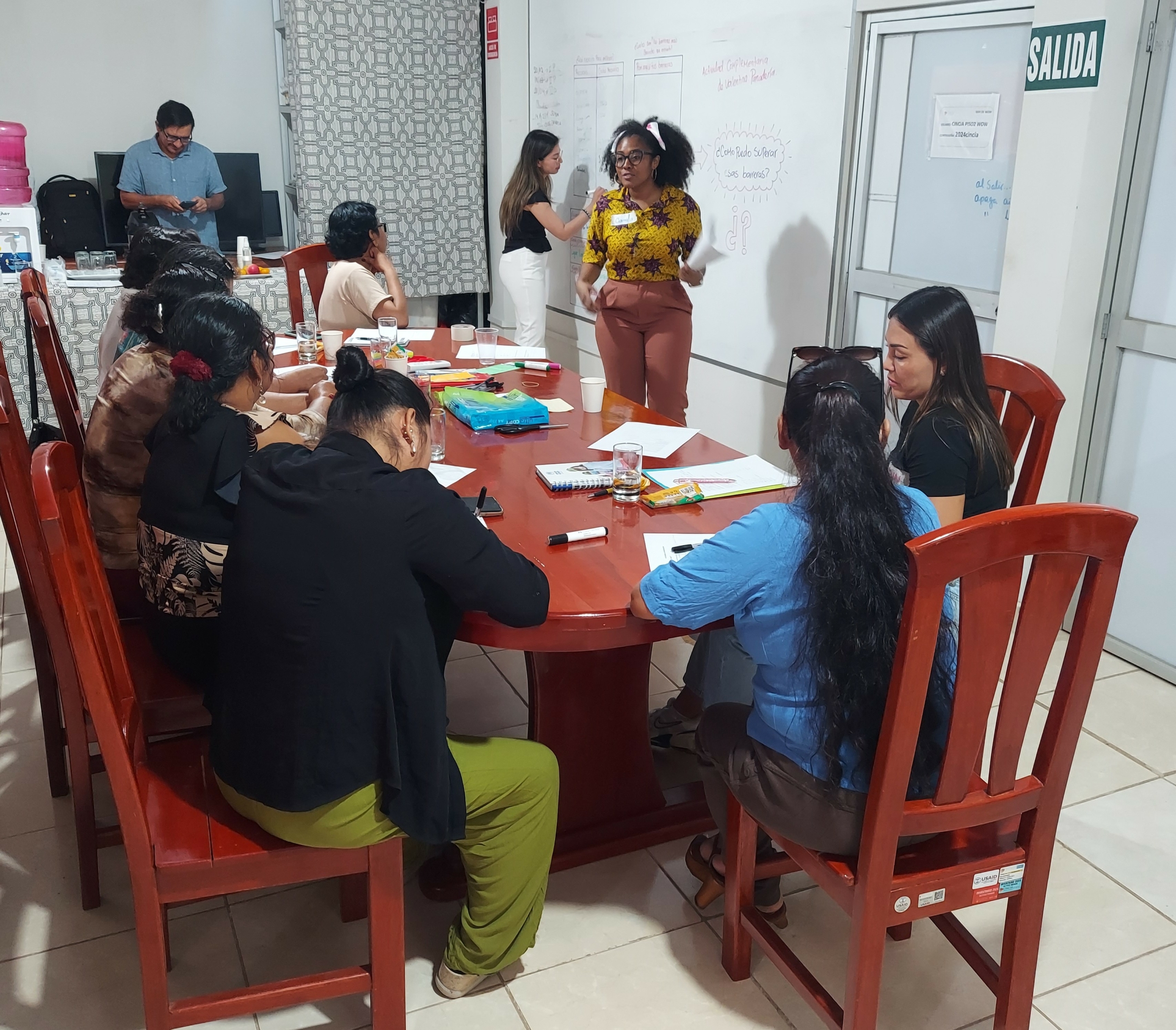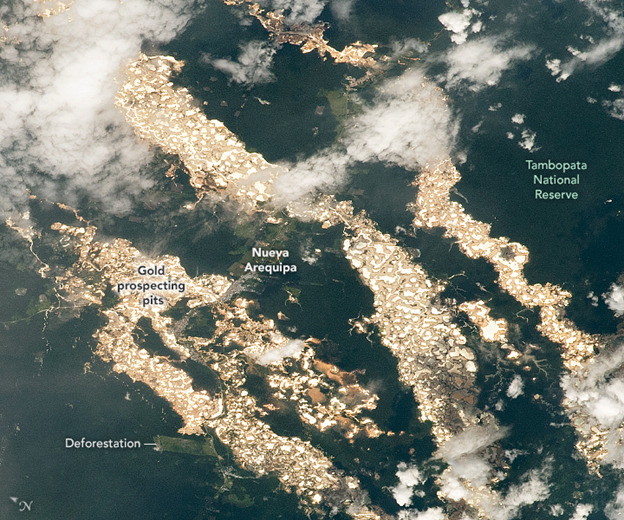Peruvian Gold: Producers, Consumers, Lands, and Livelihoods
by Alix Underwood
When I say “gold mining,” what comes to mind? Perhaps you think of the 19th-century gold rush, with prospectors in suspenders swinging pickaxes and panning for gold in rivers. Maybe you envision industrialized mining, with terraced pits and heavy machinery. A visit to the Peruvian Amazon, where gold mining has surged in recent decades, transformed my perception of gold mining and miners.

Students running a workshop with women gold miners in Madre de Dios, planning for supplementary economic activities. (CASSE)
I have the privilege of advising a team of Notre Dame master’s students—diverse in origins and expertise—as they work alongside a Peruvian NGO, CINCIA (Centro de Innovación Científica Amazónica). They are investigating supplementary economic activities for the Red de Mujeres MAPE (Minería Artesanal y Pequeña Minería). This is a network of women miners who organize to promote good practices and access new spaces related to artisanal and small-scale gold mining. CINCIA has been building trust with these miners for years, supporting their efforts to reforest closed mines. Now, due to mounting difficulties associated with mining, the network is interested in economic diversification.
My perceptions of gold mining in Madre de Dios may not be representative of the sector worldwide. However, they raise questions applicable to many extractive activities and the communities that host them:
- How do the environmental and social impacts of small-scale and industrial gold mining compare?
- Should the onus to mitigate or remedy these impacts fall on producers, who often lack economic and social security? Or is it consumers (for whom consumption is often superfluous) whose behavior needs to change?
- If demand for gold were to decrease—if the gold sector were to “degrow”—how would this affect the millions of people who extract gold for a living?
With no pretense of definitive or complete answers, let’s explore these questions in the context of Madre de Dios.
Approaching a Tipping Point in the Amazon
The Amazon is home to nearly a third of Earth’s remaining tropical rainforests. Brazil contains over half of the Amazon basin, Peru contains twelve percent, and seven countries share the rest. Often referred to as the planet’s lungs, the Amazon provides vital ecosystem services. Its trees regulate carbon and water cycles, releasing 20 billion tonnes of water into the atmosphere per day and creating a cooling effect. They also store 150–200 billion tons of carbon, enough to balance out 15–20 years of CO2 emissions, globally.

The Madre de Dios River, flowing toward the Amazon. The watershed is a treasure chest of biodiversity and gold. (Ivan Mlinaric, Flickr)
The Amazon is a biodiversity fortress. It houses ten percent of the world’s known wildlife species despite covering only one percent of Earth’s surface. Diverse humans also call the Amazon home. Of the 47 million people that live in the Amazon, 2.2 million are Indigenous. They speak around 300 languages collectively. These communities rely upon the unique ecosystem, and the entire world benefits from their ecosystem services and knowledge systems.
The Amazon’s global benefits are immeasurable, but for those who exploit it, its economic benefits are very measurable indeed. And don’t South Americans have the right to exploit their natural resources just as high-income countries have exploited theirs (and others’)?
The situation grows more complex as we blow past planetary boundaries. Scientists forecast a “tipping point,” at which the rainforest will no longer be able to generate its own rainfall and will become a dry grassland. They place the tipping point at 20–25 percent deforestation. We currently stand at 17 percent.
Peru’s Amazon: Madre de Dios
Twelve percent of Peru’s Amazon lies in the southeastern department of Madre de Dios (Mother of God). Rich in biodiversity, Madre de Dios has Earth’s greatest concentration of bird species and persisting populations of endangered mammals. It is also home to 37 Indigenous communities, several of which intentionally isolate themselves.

Most of the gold mining in Madre de Dios occurs near rivers because gold is found in riverine sediments. (Earth Observatory)
Many regard Madre de Dios as a conservation success story, as 45 percent of it is designated as Natural Protected Areas. Yet it is not exempt from the economic pressures threatening the rest of the Amazon. It has lost 4.3 percent (353,000 hectares) of its tree cover since 2000. Though other activities (primarily cattle ranching) drive deforestation elsewhere in the Amazon, gold mining is the leading driver of deforestation in Madre de Dios.
In addition to causing deforestation, many small-scale gold mining operations, especially illegal ones, use mercury irresponsibly. This impacts both the environment and human health. In Huepetuhe, a heavily mined area of Madre de Dios, epidemiologists found mercury in the urine samples of all residents who participated in the study. Several had levels associated with nervous-system impairment, tremor, and psychological disorder.
Mercury contamination disproportionately affects Indigenous communities. Gold mining often takes place on Indigenous lands (operations in the entire Amazon basin cover over 20 percent of Indigenous lands). High mercury levels have even been found in native communities far from mining sites, due to fish consumption.
In Madre de Dios, mining from water-borne sediments produces around seven tons of gold annually. On paper, Madre de Dios has the smallest and sparsest population in Peru. In reality, it is flooded with a transient population of gold miners. The result: 50,000 miners, less than 300 of whom are recognized by the government as “formal.” CINCIA emphasizes that there’s simply not enough space in the legal-mining zone for all these miners.
Not All Gold Mines Are Equal
Some miners come to Madre de Dios to make a quick buck and move on. They are not invested in the long-term well-being of the land and the communities that depend on it. However, the women gold miners I met come from families that have been mining for generations. They care about their families, employees, and communities, and some of them recognize the importance of a healthy ecosystem. One miner cried as she shared her experience of being villainized by the Peruvian government and society at large. She has tried desperately to do things right, with very little reward.
This miner had gone to great lengths to adopt mercury-free mining techniques. She uses specialized shaking tables to isolate gold, taking advantage of gold’s high density relative to other minerals. According to France Cabanillas, coordinator of CINCIA’s restoration program with MAPE actors, “Mining without mercury in Madre de Dios is possible, but it’s necessary to develop a market that pays fair (better) prices for this gold. This market needs to be open to every formal miner and easy access.”

Gold output from AMATAF (Tauro Fátima Artisanal Miners Association). They use a shaking table, as opposed to mercury, to isolate gold. (Mark Giesey)
At the moment, mercury-free technologies such as shaking tables are relatively expensive and require experience to operate. Therefore, mercury extraction methods are still far more common in Madre de Dios. These methods entail mixing gold ore with large amounts of elemental mercury to form a gold-mercury “amalgam.” Miners then use a furnace to vaporize the mercury, leaving only gold behind.
According to Cabanillas, formal miners are required to use equipment that mitigates mercury pollution. However, much of the vaporized mercury from illegal mines ends up in water bodies. There, microorganisms convert it to organic mercury compounds that can bioaccumulate in fish. This process affects any community member who inhales mercury vapors or consumes contaminated fish.
Artisanal and small-scale gold mining, especially illegal mining, is environmentally harmful (as is all economic activity, to some extent), but how does it compare to large-scale mining? Rigorous comparisons are difficult, given that much of the region’s small-scale mining is illegal and under-documented. From 2011 to 2012, small mines constituted roughly 51 percent of Madre de Dios’s total mining activity. Just under half of mining-related deforestation resulted from these small mines.
Though even more difficult to compare, pollution per unit of gold produced may indeed be higher for small mines. Many technologies designed to minimize or capture pollution are more accessible to large-scale miners, who also receive more regulatory pressure to use them. However, even in large mining operations, “mercury-free” does not mean pollution-free. Cyanide, a common mercury alternative in large operations, is lethal to aquatic wildlife and can have devastating environmental impacts when mismanaged.
It Takes Two to Tango: Producers and Consumers
It’s no coincidence that the Madre de Dios gold-mining boom from 2006 to 2010 reflected increases in gold prices. Demand drives suppliers to invest in—and exploit—resources. More recently, from 2018 to 2023, gold prices nearly doubled. This further increased mining interest, but Madre de Dios’s legal mining zones can’t accommodate many more concessions.
Who profits most from gold at the high price of $99 per gram? Madre de Dios gold often makes its way through a lengthy supply chain. The capital, Puerto Maldonado, is teeming with shops that buy gold from small-scale miners. However, only two of them are above board and can buy from formalized miners.
Most of the gold from Madre de Dios comes from informal and illegal mines and is laundered and/or mixed with legal gold before making its way to trading companies. These companies sell gold to refiners, who process and purify the gold before selling it to jewelry manufacturers, banks and investors, and electronics companies.

Switzerland’s lucrative watch market, which accounts for 60 percent of the global trade value of all watch sales, is tied to its gold market. (Unsplash, Freerange)
40 percent of global gold refining capacity is located in Switzerland. When trade is factored in, Switzerland handles 70 percent of the world’s gold. The fourth-wealthiest country in the world by some accounts, Switzerland raked in $109 billion from gold exports in 2023 ($12 thousand per Swiss citizen), compared to Peru’s $9 billion (around $250 per Peruvian).
Switzerland also has the world’s highest consumer gold demand per capita, followed by Germany, Saudi Arabia, Turkey, and the United States. In the aggregate, China and India are by far the world’s biggest gold consumers. However, per capita, they consume little more than average.
In 2023, half of the gold consumed globally was used in the form of jewelry, a quarter as investments, around 20 percent by central banks, and seven percent for technology. Jewelry serves different purposes in different contexts. Indian households, especially in low-income communities, often use gold jewelry as savings or collateral for loans or to hedge against inflation. In Europe and the United States, gold jewelry is a luxury item that people wear as a symbol of status, wealth, and style.
What if We “Degrow” the Gold Market?
Market analysts expect global gold mining to grow at an annual rate of three percent, reaching almost $250 billion by 2026. What if, given gold mining’s environmental and social impacts, an enlightened global society made a concerted effort to reverse this trend? What if we applied steady-state principles to the gold market, such that the production and consumption of this nonrenewable resource gradually decreased to near zero, with recycled gold satisfying remaining demand?
Disregarding for now the feasibility of this proposal, let us consider its potential impact. Assuming some more-destructive good did not fill the gold void, this scenario would be a net environmental positive. There would be less deforestation and contamination of the Amazon and other invaluable, irreplaceable ecosystems. Given that humanity depends upon a functioning planet, we could equate a net environmental positive to a net social positive.
However, such a steady-state transition would also negatively affect many people. On my trip to Peru, I met some of those people. They want—they deserve—stable livelihoods just as much as the next person. Degrowth and steady-state initiatives must intentionally support impacted producers, helping to identify alternative income sources and the ways and means of redistributing wealth.
CINCIA embodies this value without wearing a steady-state label. They were one of the first organizations in Madre de Dios to work with, not against, small-scale miners. They are building trust with the network of women miners and, in a sensitive manner that does not villainize them, encouraging them to develop supplementary livelihoods.

Students traipse through the mud to reach a miner’s supplementary livestock operation. (CASSE)
The Notre Dame team is compiling information on some of the more promising supplementary activities, including fish farming, livestock husbandry, and ecotourism. They will compare these activities in terms of economic viability and environmental impact. They will package the information for the women miners in the hopes that it will contribute to CINCIA’s campaign to empower miners to invest in activities outside of mining.
This is not a new concept for the women miners. During our visit, many of them expressed a growing concern about the security of gold mining as a livelihood, regardless of environmental factors. Some are running out of land, some feel the work is too hard on their aging bodies, and many have been the victims of extortion.
This rings of local limits to growth, which many producing regions are encountering before the formation of any intentional, steady-state strategies. Where capacity-building initiatives like CINCIA’s aren’t enough, they must be supplemented by wealth redistribution. We badly need models for decreasing demand from the wealthy without devastating people whose livelihoods depend on that demand. The women gold miners of Madre de Dios may someday serve as a model of inclusive livelihood transitions.
 Alix Underwood is managing editor at CASSE.
Alix Underwood is managing editor at CASSE.





This is a finely drawn narrative, underscoring the ways in which the sustainable (or at least potentially sustainable) activities of indigenous communities (or of those who dwell in lightly-developed regions of the world) are often intertwined–almost inescapably–with the interests of those who can ignore the fragility of these regions. We’ve known for decades that the demand for gold as a hedge against inflation (by private investors and national governments) is little more than a relic of an unwise and superstitious era, which we should have abandoned years ago. Sir Isaac Newton understood this in the 17th century. Since this constitutes roughly 45 percent of global demand for this “filthy lucre,” there is every opportunity to begin a transition recommended by Ms. Underwood’s analysis, by which production may soon be limited to recycling and certified and regulated low-scale production, even limiting the latter, perhaps, to the indigenous peoples with the best sense for the often hidden environmental externalities. Once the archaic “hedging” behavior is marginalized, there is also no reason not to limit purchases of the residual small-scale production, reserving it to a governmental body, national or international, at a fixed price, with strict producer certification standards and corresponding licensing requirements for any secondary market purchasers (jewelers, artists, industrial users). The time has come, perhaps, to retire–in Keynes’s famous characterization–this “barbarous relic.”
The gold mining parallels with bitcoin mining, much harm being done in pursuit of creating an in demand scarce store of value. Bitcoin is virtual and gold simply held for value storage and status displaying. Bitcoin has zero practical value, while gold has some real value as an electronic material, albeit a mere fraction of the market value. Ultimately demand drives supply. How can we alter the economic system to encourage responsible demanding? The answer lies in a shift towards competing cooperative suppliers replacing the for growth & profit suppliers. Cooperative suppliers can encourage responsible consumer behaviour, which in turn can support and grow the cooperative supply sector ultimately eroding the growth economy. A way to deliver a viral shift in consumer behaviour could be on a responsible consumer reward scheme, the rub being that all of the other consumers see how one another is doing. With the emergence of responsible environmental reputations firstly among early adopters, then driven by the socials, consumer behaviour change can go viral, while the sector of responsible producer cooperatives exponentially grows replacing the old irresponsible growth brigade with its tired lying message of consumption makes you happy.
For the ladies of Madre de Dios, how does this pan out, forgive the pun. Less demand for gold, maybe replaced by responsible cooperative suppliers ringfencing the Amazon with clean production facilities producing durable essential items fand services for ethical consumers to buy,thus enhancing their reputations, no longer with showy gold, but with their commitment to look after one another and the planet.
Amazon went viral from Jeff Bezos’ garage a few years back. Maybe a consumer owned cooperative established by ladies from Madre de Dios can grow virally, doing the right thing, no longer reduced to tears.
Thanks for these valuable inputs, Dave and Conor! France Cabanillas, who shared his expertise for this article, sent me a new piece on mercury-free mining by women in Madre de Dios. Sharing here, as I think it complements this article: https://www.context.news/nature/in-perus-amazon-women-gold-miners-ditch-toxic-mercury